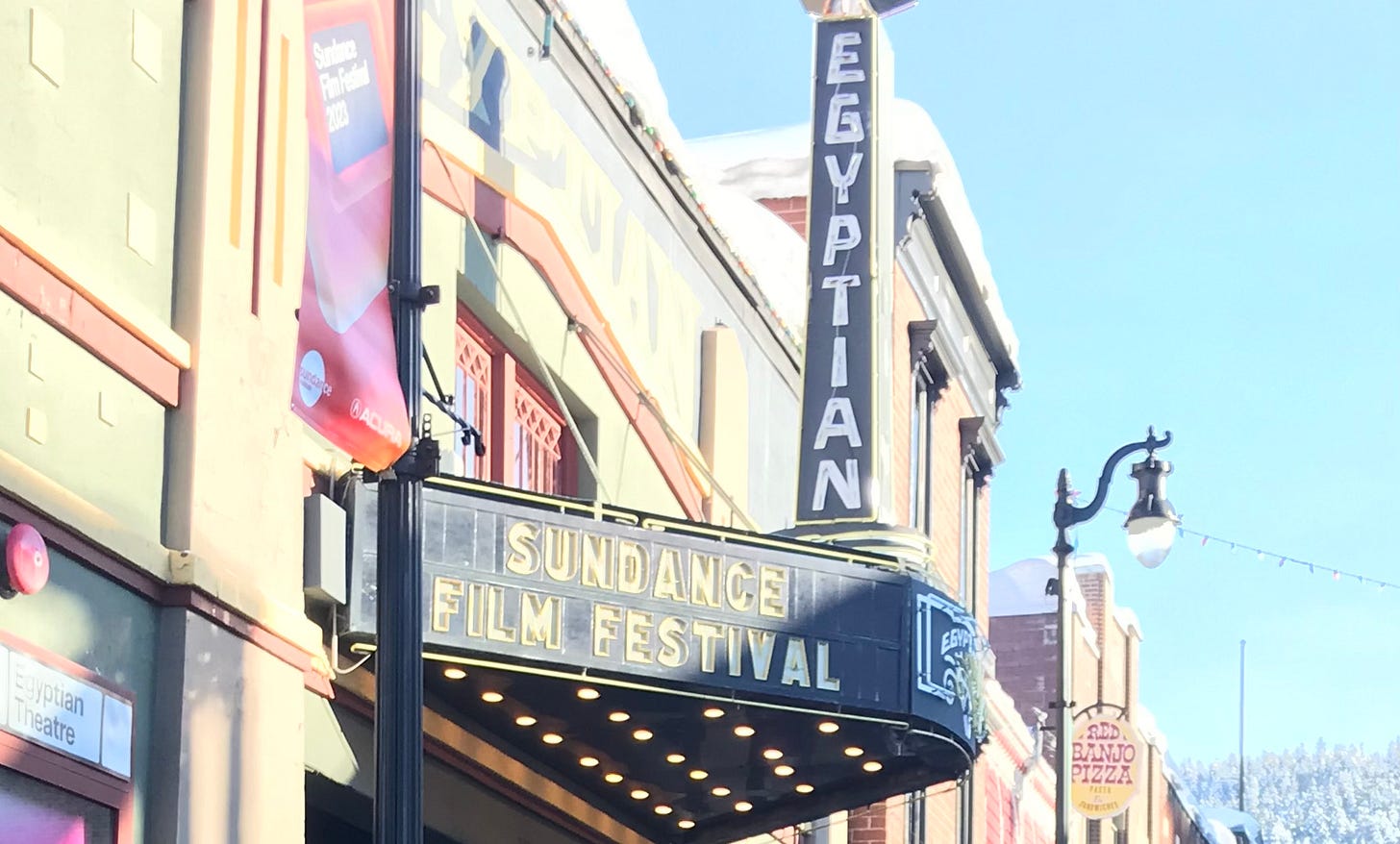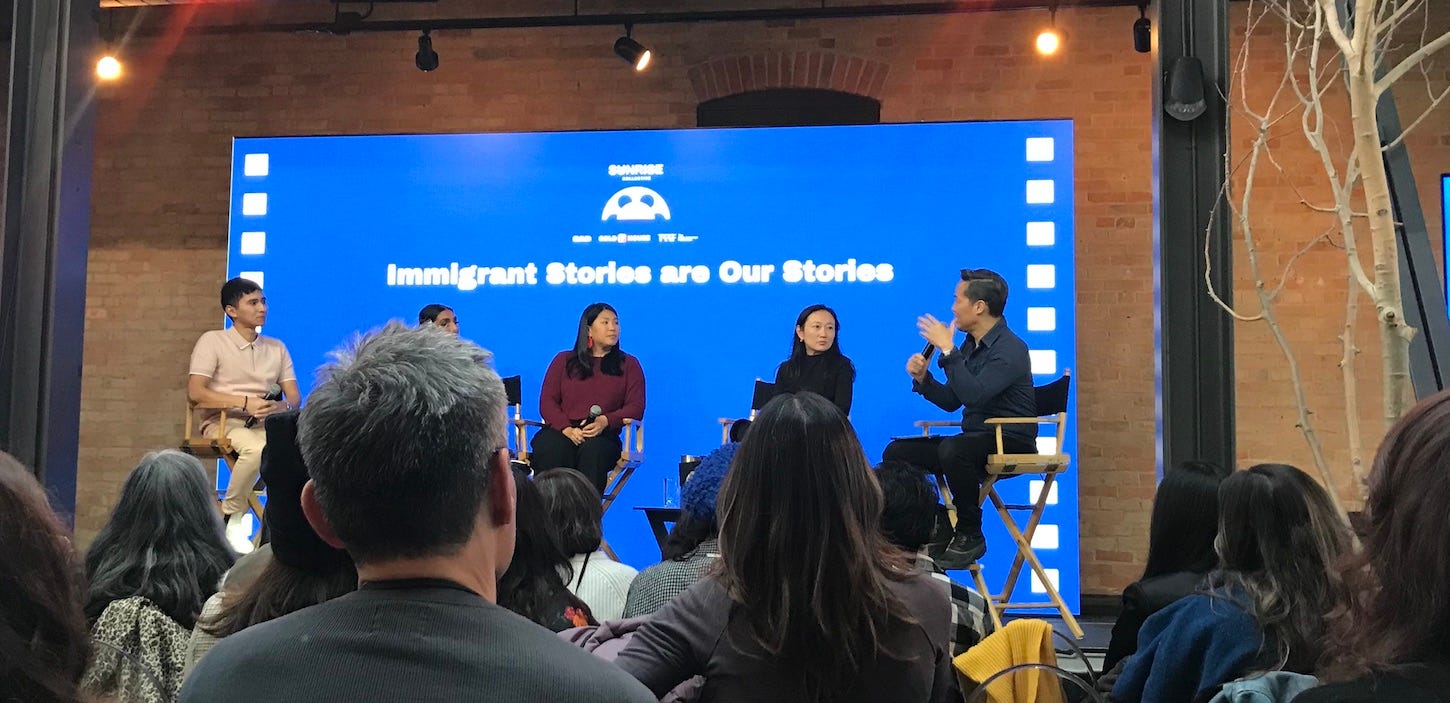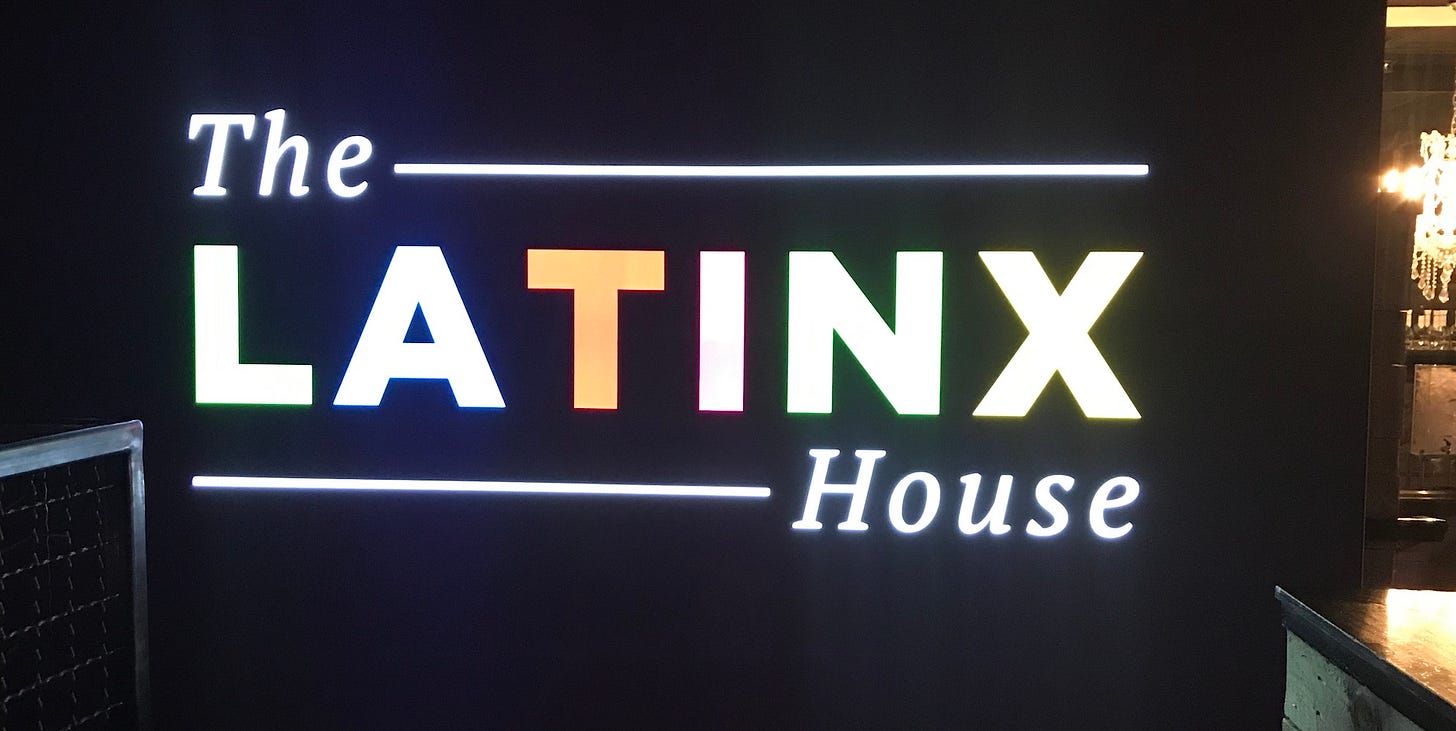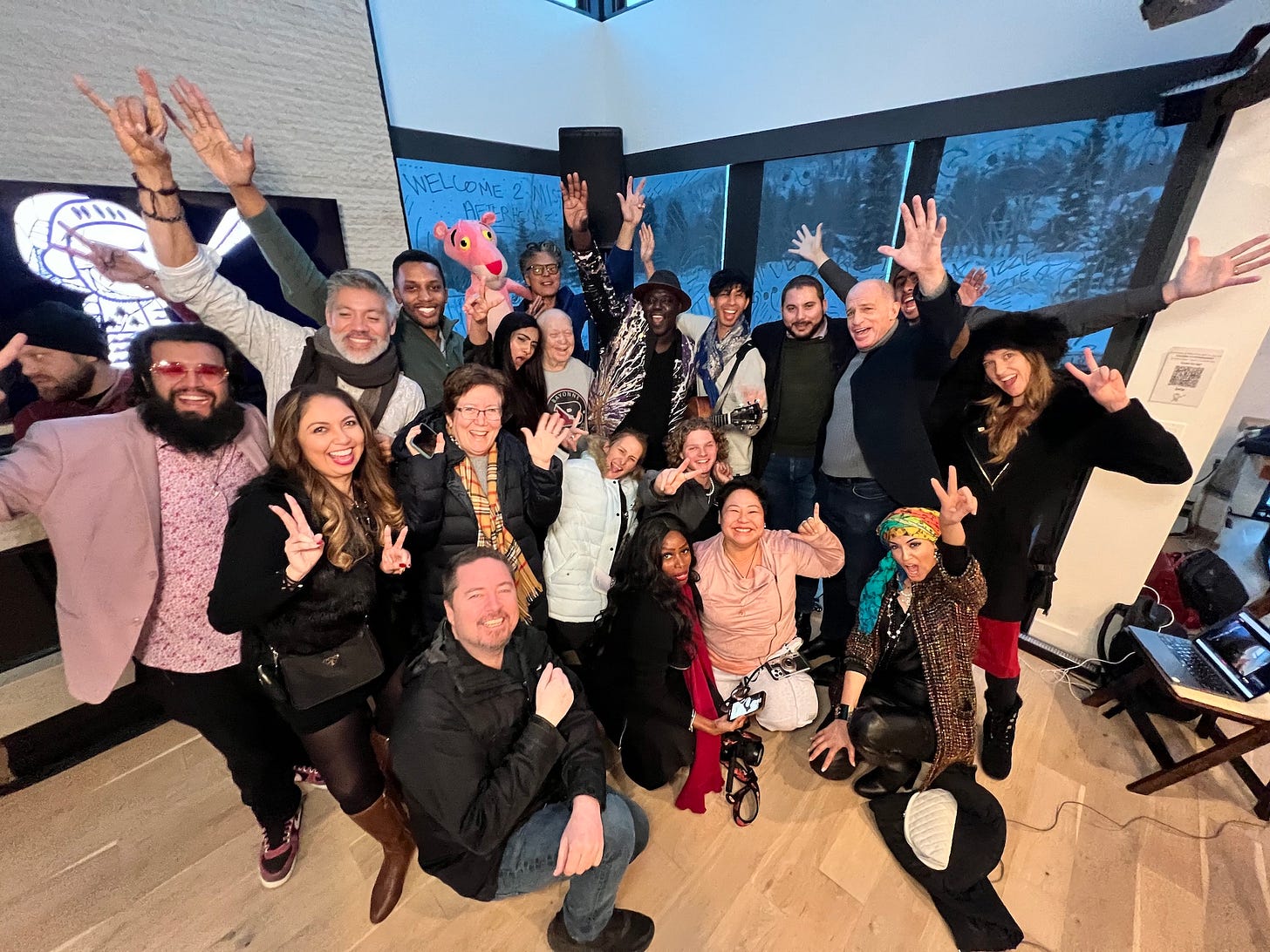I was at the Sundance Film Festival in Park City, Utah, this past weekend, and since it’s a unique experience that doesn’t happen every day, I thought I’d use this week’s newsletter to tell you about it.
I was invited to speak in a series called the “2050 Forums,” tied to the question of what we must do to ensure a sustainable planet and society by 2050. Nowadays, organizations and event producers rent “houses” at Sundance—either private residences or bars / restaurants in Park City—as venues for programming and advancing causes. For example, the speakeasy O.P. Rockwell was rented by a nonprofit called Justice for Migrant Women, with support from the Ford Foundation, and turned into a Hispanic-themed venue dubbed The LatinX House. Organized by an activist and two L.A.-based filmmakers, including the daughter of political journalist Morton Kondracke, the LatinX House featured events such as a “Climate Storytelling Panel” and a “Film Conversation with Sorcery.” There were several such houses around town, including a Europe!Hub and an Acura Village.
➡️ Speaking of events, this week the History Communication Institute is co-hosting a roundtable discussion on ChatGPT and A.I. on Wednesday, February 1st at 12 PM ET. More than 100 people have registered; RSVP here if you’d like to attend.
SUNDANCE, DAY 1
We flew into Salt Lake City on Friday evening, and it being late for my wife and I, we did not venture up the mountain to Park City until Saturday morning. Apart from speaking, I had an ulterior motive; there has been some interest in adapting my book, History, Disrupted, into a documentary. Part of my objective at Sundance was to talk to people in the industry.
My first meeting was with a woman who works at the Sundance Institute, the $60 million nonprofit that stewards the festival. We met at a coffee shop on Main Street called Java Cow, which by 9:30 a.m. had a line out the door; for a croissant and a cup of tea, we were charged $17. During breakfast, which was very pleasant, my conversation partner pointed out various VIPs among us: a film director here, an important financier there. We also met a young filmmaker named Kay Barnes, who had been waiting in line with us. She was from Alabama, had served in the military, and now had a production company called Entangled Butterfly Entertainment. Among her recent credits were projects for HBO and A&E.
We then walked onto sunny and snowy Main Street, already teeming with traffic. Our next destination was the Sunrise Collective, a house organized by The Asian American Foundation (TAAF). For those unfamiliar, TAAF emerged out of the Covid-19 pandemic as an advocacy organization to support Asian American causes. It was founded by wealthy tycoons Joe Tsai (owner of the NBA’s Brooklyn Nets); Jerry Yang (co-founder of Yahoo!); and Li Lu, founder of the hedge fund Himalaya Capital, among others, with an initial investment of $125 million over five years.
One might wonder, why would TAAF have a presence at Sundance? Among TAAF’s priorities is what their leadership calls “narrative change,” with a specific focus on arts, film and media. Essentially, TAAF wants more AAPI faces and experiences on-screen as part of its broader advocacy goals, and has put significant money behind that effort. Another TAAF priority is to get AAPI curriculum taught in schools, and they are actively working state-by-state to do so.
The first TAAF panel felt more like Washington, D.C., than Hollywood. It featured a staffer from the Sen. John Fetterman campaign; a senior advisor to the Biden White House; a former Obama staffer; a sitting Member of Congress; and a political journalist. My wife and I joked that we had flown 2,000 miles across the country to see the exact same people we see on Capitol Hill.
But for the purposes of this newsletter, and as educated voters and citizens, it’s important to be aware of how interconnected the worlds of media, entertainment, politics and activism have become. The Biden campaign raised $1.6 billion during the 2020 election, with $60 million apiece coming from New York and Los Angeles—the centers of American media and entertainment. Significant funds for Democratic candidates have come from wealthy AAPI donors and political action committees (PACs), and the Biden Administration has reciprocated by issuing executive orders against AAPI hate, launching a national strategy for Asian Americans communities, and cultivating Asian American voters. My wife and I have attended several AAPI-themed Zoom calls hosted by The White House.
As the 2024 Presidential election cycle begins, Reuters has reported that Biden is already courting wealthy donors on the East and West Coasts. It is not hard, then, to connect the dots: Members of Congress and administration officials fly across the country to Sundance (using tax-payer dollars, by the way) to take part in an event hosted by an AAPI advocacy organization with $125 million in the bank and several billionaires behind it. Even as my wife and I are very active in support of AAPI causes, as citizens and taxpayers we have an obligation to understand how large donors influence our democracy. These are some of the ways by which it happens.
Following the panel was a luncheon, wherein we met some interesting and engaging individuals. We met a film financier who co-founded the Giant Leap Accelerator, which aims to pair emerging filmmakers with mentors in hopes of producing more AAPI-led projects; a young screenwriter working on a script about Japanese-American internment; a half Irish Catholic and half Indian-Pakistani Burmese Muslim film director whose feature debut was a comedy about women’s arm wrestling; and a Japanese filmmaker with more than 20 projects to her credit who had recently moved from Tokyo to Los Angeles. We also met numerous activists, underscoring how documentary filmmaking has become highly-contested ground in the culture wars. Just this past year, the Ford Foundation spent $4 million on social justice documentaries. Not to be outdone, Conservative organizations such as Daily Wire Entertainment have entered the documentary business as well, most recently financing a film about Black Lives Matter hosted by Candace Owens.
Following a second panel called “Immigrant Stories Are Our Stories,” we went back onto Main Street to meet a friend who lives in Park City. We walked into the Stanley house and walked out with several free thermoses, after which we ventured over to the aforementioned LatinX House. It was there that we had our first celebrity encounter: Brooke Shields and George Stephanopoulos. The pair were at Sundance promoting a new documentary titled “Pretty Baby,” produced by Stephanopoulos and ABC News Studio.
If you’re noticing a recurring theme of documentaries, you are correct. We are living through a gold rush in documentary filmmaking—or as The Hollywood Reporter has described it, a “cash grab.” Hundreds of millions of dollars are being pumped into documentaries about newsworthy people or headline-grabbing topics with the hopes of selling them to Amazon, Netflix, Hulu, Apple+, HBO Max or other streaming services. According to THR, the number of original streaming documentaries increased 77 percent between January 2019 and July 2022, and multibillionaires such as Laurene Powell Jobs (Steve Jobs’s widow) are now among the super-wealthy backing documentary studios, in addition to activists, political parties, celebrities, corporate media and Silicon Valley. The content we see in our streaming libraries have very powerful agendas behind them; understanding that is a critical part of being a media literate information consumer in the 21st century.
In regards to Brooke Shields and George Stepanophalous, I can report that Stepanophalous is quite short and Brooke Shields is very tall. Shields also had, quite possibly, the most imposing entourage I have ever encountered—and I live in Washington, D.C. Shields had at least seven individuals around her as they barged through the hallway with complete disregard for other humans. A short man who looked like he could bench press a tractor-trailer led the way, followed by a very tall gay man directing traffic. Then came other security guards with ear pieces, and, finally, a short woman in a chapeau asking a string of questions about where Brooke should walk and where Brooke should go next.
Once the commotion had subsided, we began to enjoy the LatinX house. We accumulated more free stuff (a friend of mine told me she used to bring an empty suitcase with her to Sundance solely to carry shwag). We met a lovely couple, Benny and Marla, who we struck up a conversation with after they offered to take our picture. As it turned out, Benny and I were dressed almost identically, which allowed us to laugh and become instant friends. Marla is a Latina artist whose work was on display in the house. She had just sold a painting to Delta, about which we joked that they should give her free access to all Sky Lounges worldwide. (Delta, if you’re reading, make it happen).
After the LatinX house came our least favorite part of Sundance: the traffic. We had parked our rental car at a park-and-ride down the mountain, and it took 90 minutes to travel 11 miles via shuttle bus back to our spot. Feeling as though we had earned dinner, we found a family-owned ramen bar in Kimball Junction, Utah, where our waitress was Chinese American. She told us that following her shift she was off to the airport to take a red eye to New York and join her family for the Lunar New Year. We asked why she lived in Salt Lake City as opposed to New York City and she replied simply, “To get away from my mom.”
We’d been told the best parts of Sundance are the private parties, so, after dinner, we went to a private party at the Lighthouse. The gathering featured an eclectic group of individuals that included a team of young black filmmakers from Salt Lake City who had adopted the name of the Sankofa Collective. Sankofa derives from the Akan people of Ghana and roughly translates to “go back to the past and bring forward that which is useful,” according a definition on the Southern Illinois University School of Africana & Multicultural Studies website. The young man we met was a portrait photographer who had also appeared in several Broadway productions that came through Salt Lake City. After a few hours at the party, we drove back to our AirBnB to get some rest.
SUNDANCE, DAY 2
The next day we woke up to snowfall, a reminder that winter still exists in some parts of the U.S. In Washington, D.C., it’s common for it to be 50 degrees in January (as it is at time of writing), but in Park City the temperature dropped to 3 degrees Fahrenheit overnight (-16 C for my international readers).
In the cold and snow, we drove back up the mountain to the Misfit House, the venue for the 2050 Forums. Unbeknownst to me, I’d been scheduled as the penultimate speaker, a purposeful strategy by the organizers to have my insights serve as a capstone to the day. That allowed me to listen to the speakers who came before me, which included:
Two blockchain lawyers who remain bullish on blockchain and crypto technology despite a down year and the collapse of several exchanges, most notably FTX. On FTX, the attorneys were adamant that the collapse was a matter of fraud and malfeasance by Sam Bankman-Friend and his inner circle, and not indicative of the crypto industry as a whole;
An entrepreneur who is seeking to create the NCAA-equivalent for college and high school drama clubs;
The filmmaker Ramfis Myrthil speaking about his new film “Ricky” that debuted at Sundance this year;
The founder of a company called ESAIYO that seeks to codify the Social Identity of Objects; and,
A panel of women entrepreneurs speaking about artificial intelligence and the singularity.
Long-time readers of this newsletter will not be surprised that I had serious concerns about the A.I. panel, including the notion that the singularity—the day when machine intelligence supersedes human intelligence—is both desirable and inevitable (I believe it is neither of those two things).
One of the panelists was a Utah lawmaker who exhorted that the only thing government does better than private citizens is national defense. As such, the government should almost entirely remove itself from regulation and allow private entities to do as they wish. Not surprisingly, I took the opportunity during my remarks to remind her that there are many things the government does well, including fund the humanities, which, if it were not for the federal government, would cease to exist in the United States—not to mention the Library of Congress, the Smithsonian, the National Endowment for the Arts (whose initial support made Sundance possible 40 years ago), NASA, the National Park Service, Pell Grants, DARPA, international diplomacy, the Environmental Protection Agency and many more. Government plays an important role in all of our lives, which is why it’s incumbent on us to vote, participate and hold it accountable when it runs astray.
Finally, it was my turn for a fireside conversation about History, Disrupted. I’ve posted the full, unedited conversation on my YouTube channel for those who want to watch it; a more polished, professional version is forthcoming. The main thrust of my comments was to remind the audience that it was not solely music, art and film that shape culture and society—it is also scholarship, particularly historical scholarship. Without historical research, we would know very little about our world and society. Yet, professional history remains woefully underfunded as billions of dollars are spent on tech, politics, activism and entertainment. My message to the assembled crowd was to remember our responsibility to invest in history and the humanities before both disappear. It served as a nice coda to the day, as everything up to that point had been about the future, not the past, which is often the case at these festivals. Many people approached me afterwards to tell me that they appreciated my remarks.
The event concluded with a performance by a charming young singer / songwriter named Max Louis, including his cover of Crowded House’s “Don’t Dream it’s Over.” A small group of us then went to Five Guys for celebratory hamburgers, wherein the song “Extra Ordinary” was playing in-store. When I began to sing along, the young man behind the counter looked at me funny. I told him the song was popular when I was his age. He said he’d never heard it. I asked him if he could guess who sang it, to which he said no. “Better Than Ezra,” I said. “Never heard of them,” he told me.
Finally, we returned to the Lighthouse for an intimate dinner and more performances. An indigenous woman from Siberia played an instrument that rested inside her mouth while she made animal noises, one of the most spectacular performances I have ever seen. The hosts then held a lantern ceremony to remember lost loved ones. A Shamanatrix named Missy Galore gave us all feathers and told us to fluff each other while she chanted, “The More You Fluff It, The Better the Vibe” (her Fluff the Goodness video has more than 56,000 views on YouTube). Later, a fruit artist from Mexico asked everyone to dice up a fruit of their choice in order to form a fruit palace. It was at that point that we decided to call it a night.
Our remaining time in Utah was spent exploring the history and culture of the state beyond Park City. Utah is a fascinating and complex place, and I left with enough content to fill several newsletters, which I will hopefully write in the coming weeks. Highlights of what we saw included a trek to Golden Spike National Historical Park, where the two transcontinental railroads met in 1869, videos from which are on my Instagram and YouTube.
Overall, our time at Sundance was lovely. Like all things, though, there are unsettling elements that often go unspoken. Sundance is highly classist and exorbitantly expensive—not solely $17 for a croissant and tea, but up to $4,000 per night for accommodations. It takes a lot of money to be there, and the influence of large corporations, billionaires and political elites are everywhere. The space for independent filmmakers; those without status, money or means; and the voices of those outside the spheres of influence of Hollywood or Washington, D.C., feel largely silenced. For a festival that began as a means to champion independent voices, it can feel almost impenetrable for independent voices to participate.
Utah also has some of the worst air quality in the nation, with Salt Lake City having the 7th worst air among large U.S. cities. Polluted air shaves between 1.1 and 3.5 years off the average Utahn’s life, according to a study by Brigham Young University. That pollution gets far worse during Sundance as the mountains trap emissions from thousands of cars and planes coming in and out. The effects are felt by the locals who live there, not by the visitors who leave after three days. For a festival dominated by advocacy for Progressive causes, there seemed to be no compunction about the smoke, pollution and waste that gets left behind.
For me, the lasting memory of this Sundance will be the tears. That was what I did not expect, and also what moved me so deeply. At the TAAF house, when speakers spoke about their immigration stories and trying to find a sense of belonging amid multiple countries and cultures, there were tears in their eyes. At Misfit House, when speakers spoke about societal injustices past and present, there were tears in their eyes. When we all sang the chorus of “Don’t Dream it’s Over,” together, especially the line “We know that they won’t win,” led by Max Louis, there were tears in our eyes. When we lit lanterns to remember loved ones lost over the past few years, there were tears in our eyes. I even cried, in part because everyone around me was crying but also because as I reflected on my own past few years, I realized there were so many emotions that I had never allowed myself to express as I hustled from one engagement to the next.
Upon reflection, I began to realize that we have all experienced tremendous trauma and loss the past few years—trauma that we have not fully processed as we’ve raced from one crisis into another. We are all processing a lot of grief, and maybe we haven’t had as much chance to do so communally as we need. We’ve had relatives die in isolation, in hospitals or in nursing homes; empty funerals; empty schools; empty offices; lock downs; canceled conferences (this was the first in-person Sundance since Covid); and so much death, violence and strife beamed into our consciousness each day via our screens. The past few years have felt like one calamity after another, the pace accelerated by media coverage and social media that thrive on outrage and sensationalism. We haven’t given ourselves the chance to process it and let it out. But that is what art does, right? Art offers us a forum to cry, yell, laugh, sing, mourn, embrace, reflect and feel—and spaces where it is okay to do so.
At their best, film and the arts grant us the permission to be human. That permission was, by far, my favorite part of this year’s Sundance.
Have good week. Happy Lunar New Year to you and yours.
-JS





Engaging, thoughtful, and poignant. Thanks, Jason.
Thanks for this terrific peek into Sundance for the benefit of those of us who will never experience it. I wonder how many of the documentaries that are so popular now have history-related content.